Related Research Articles
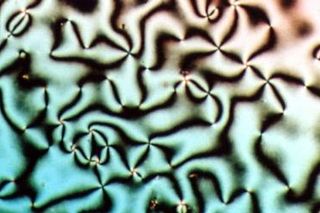
Liquid crystal (LC) is a state of matter whose properties are between those of conventional liquids and those of solid crystals. For example, a liquid crystal can flow like a liquid, but its molecules may be oriented in a common direction as in solid. There are many types of LC phases, which can be distinguished by their optical properties. The contrasting textures arise due to molecules within one area of material ("domain") being oriented in the same direction but different areas having different orientations. An LC material may not always be in an LC state of matter.
Superfluid helium-4 is the superfluid form of helium-4, an isotope of the element helium. A superfluid is a state of matter in which matter behaves like a fluid with zero viscosity. The substance, which looks like a normal liquid, flows without friction past any surface, which allows it to continue to circulate over obstructions and through pores in containers which hold it, subject only to its own inertia.
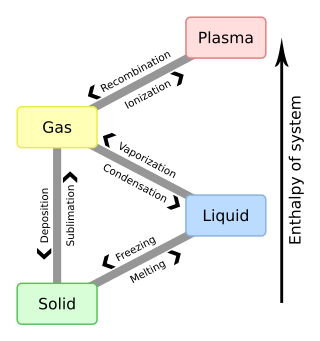
In chemistry, thermodynamics, and other related fields, a phase transition is the physical process of transition between one state of a medium and another. Commonly the term is used to refer to changes among the basic states of matter: solid, liquid, and gas, and in rare cases, plasma. A phase of a thermodynamic system and the states of matter have uniform physical properties. During a phase transition of a given medium, certain properties of the medium change as a result of the change of external conditions, such as temperature or pressure. This can be a discontinuous change; for example, a liquid may become gas upon heating to its boiling point, resulting in an abrupt change in volume. The identification of the external conditions at which a transformation occurs defines the phase transition point.
Quantum turbulence is the name given to the turbulent flow – the chaotic motion of a fluid at high flow rates – of quantum fluids, such as superfluids. The idea that a form of turbulence might be possible in a superfluid via the quantized vortex lines was first suggested by Richard Feynman. The dynamics of quantum fluids are governed by quantum mechanics, rather than classical physics which govern classical (ordinary) fluids. Some examples of quantum fluids include superfluid helium, Bose–Einstein condensates (BECs), polariton condensates, and nuclear pasta theorized to exist inside neutron stars. Quantum fluids exist at temperatures below the critical temperature at which Bose-Einstein condensation takes place.
The λ (lambda) universality class is a group in condensed matter physics. It regroups several systems possessing strong analogies, namely, superfluids, superconductors and smectics. All these systems are expected to belong to the same universality class for the thermodynamic critical properties of the phase transition. While these systems are quite different at the first glance, they all are described by similar formalisms and their typical phase diagrams are identical.

In physics, a quantum vortex represents a quantized flux circulation of some physical quantity. In most cases, quantum vortices are a type of topological defect exhibited in superfluids and superconductors. The existence of quantum vortices was first predicted by Lars Onsager in 1949 in connection with superfluid helium. Onsager reasoned that quantisation of vorticity is a direct consequence of the existence of a superfluid order parameter as a spatially continuous wavefunction. Onsager also pointed out that quantum vortices describe the circulation of superfluid and conjectured that their excitations are responsible for superfluid phase transitions. These ideas of Onsager were further developed by Richard Feynman in 1955 and in 1957 were applied to describe the magnetic phase diagram of type-II superconductors by Alexei Alexeyevich Abrikosov. In 1935 Fritz London published a very closely related work on magnetic flux quantization in superconductors. London's fluxoid can also be viewed as a quantum vortex.
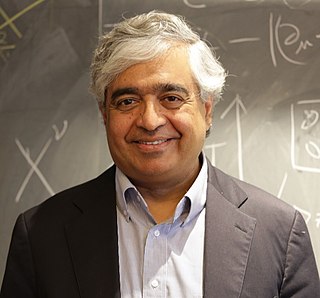
Subir Sachdev is Herchel Smith Professor of Physics at Harvard University specializing in condensed matter. He was elected to the U.S. National Academy of Sciences in 2014, and received the Lars Onsager Prize from the American Physical Society and the Dirac Medal from the ICTP in 2018. He was a co-editor of the Annual Review of Condensed Matter Physics from 2017–2019.
Multi-particle collision dynamics (MPC), also known as stochastic rotation dynamics (SRD), is a particle-based mesoscale simulation technique for complex fluids which fully incorporates thermal fluctuations and hydrodynamic interactions. Coupling of embedded particles to the coarse-grained solvent is achieved through molecular dynamics.
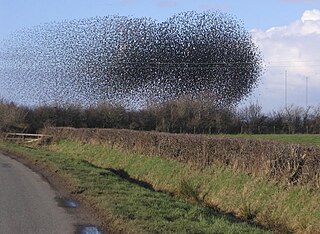
Active matter is matter composed of large numbers of active "agents", each of which consumes energy in order to move or to exert mechanical forces. Such systems are intrinsically out of thermal equilibrium. Unlike thermal systems relaxing towards equilibrium and systems with boundary conditions imposing steady currents, active matter systems break time reversal symmetry because energy is being continually dissipated by the individual constituents. Most examples of active matter are biological in origin and span all the scales of the living, from bacteria and self-organising bio-polymers such as microtubules and actin, to schools of fish and flocks of birds. However, a great deal of current experimental work is devoted to synthetic systems such as artificial self-propelled particles. Active matter is a relatively new material classification in soft matter: the most extensively studied model, the Vicsek model, dates from 1995.

Michael Elmhirst Cates is a British physicist. He is the 19th Lucasian Professor of Mathematics at the University of Cambridge and has held this position since 1 July 2015. He was previously Professor of Natural Philosophy at the University of Edinburgh, and has held a Royal Society Research Professorship since 2007.

Julia Mary Yeomans is a British theoretical physicist active in the fields of soft condensed matter and biological physics. She has served as Professor of Physics at the University of Oxford since 2002.

John Francis Brady is an American chemical engineer and the Chevron Professor of Chemical Engineering and Mechanical Engineering at the California Institute of Technology. He is a fluid mechanician and creator of the Stokesian dynamics method for simulating suspensions of spheres and ellipsoids in low Reynolds number flows. He is an elected fellow of the American Physical Society, a fellow of the Society of Rheology, as well as a member of the National Academy of Sciences, the National Academy of Engineering, and the American Academy of Arts and Sciences.
Hyperuniform materials are characterized by an anomalous suppression of density fluctuations at large scales. More precisely, the vanishing of density fluctuations in the long-wave length limit distinguishes hyperuniform systems from typical gases, liquids, or amorphous solids. Examples of hyperuniformity include all perfect crystals, perfect quasicrystals, and exotic amorphous states of matter.
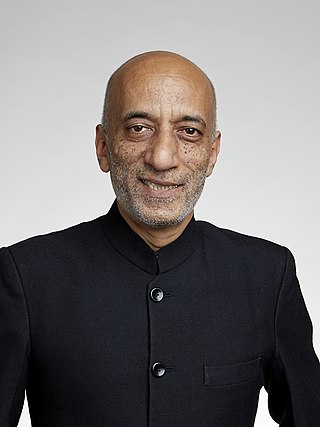
Sriram Rajagopal Ramaswamy is an Indian physicist. He is a professor at the Indian Institute of Science, Bangalore, and previously the director of the Tata Institute of Fundamental Research (TIFR) Centre for Interdisciplinary Sciences in Hyderabad.

Maria Cristina Marchetti is an Italian-born, American theoretical physicist specializing in statistical physics and condensed matter physics. In 2019, she received the Leo P. Kadanoff Prize of the American Physical Society. She held the William R. Kenan, Jr. Distinguished Professorship of Physics at Syracuse University, where she was the director of the Soft and Living Matter program, and chaired the department 2007–2010. She is currently Professor of Physics at the University of California, Santa Barbara.

Phase separation is the creation of two distinct phases from a single homogeneous mixture. The most common type of phase separation is between two immiscible liquids, such as oil and water. This type of phase separation is known as liquid-liquid equilibrium. Colloids are formed by phase separation, though not all phase separations forms colloids - for example oil and water can form separated layers under gravity rather than remaining as microscopic droplets in suspension.
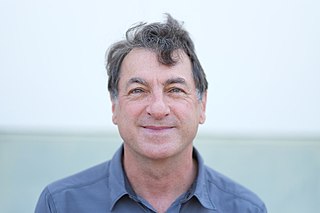
Mark John Bowick is a theoretical physicist in condensed matter theory and high energy physics. He is the deputy director of the Kavli Institute for Theoretical Physics at the University of California, Santa Barbara, and a Visiting Distinguished Professor of Physics in UCSB's Physics Department.
Allan Adams is an American physicist and oceanographer. His research in physics has focused on string theory, QFT, and fluid dynamics, while his work in oceanography and ocean engineering have focused on high-precision optical sensing and imaging and on low-cost scalable instrumentation. He currently leads the Future Ocean Lab at Massachusetts Institute of Technology and is a visiting oceanographer at the Woods Hole Oceanographic Institution.
Hartmut Löwen is a German physicist working in the field of statistical mechanics and soft matter physics.
Turbulent phenomena are observed universally in energetic fluid dynamics, associated with highly chaotic fluid motion involving excitations spread over a wide range of length scales. The particular features of turbulence are dependent on the fluid and geometry, and specifics of forcing and dissipation.
References
- ↑ Morozov, Alexander (2017-03-24). "From chaos to order in active fluids". Science. 355 (6331): 1262–1263. Bibcode:2017Sci...355.1262M. doi:10.1126/science.aam8998. ISSN 0036-8075. PMID 28336624. S2CID 5238817.
- 1 2 3 4 Saintillan, David (2018). "Rheology of Active Fluids". Annual Review of Fluid Mechanics. 50 (1): 563–592. Bibcode:2018AnRFM..50..563S. doi: 10.1146/annurev-fluid-010816-060049 .
- ↑ Marchetti, M. C.; Joanny, J. F.; Ramaswamy, S.; Liverpool, T. B.; Prost, J.; Rao, Madan; Simha, R. Aditi (2013-07-19). "Hydrodynamics of soft active matter". Reviews of Modern Physics. 85 (3): 1143–1189. Bibcode:2013RvMP...85.1143M. doi:10.1103/RevModPhys.85.1143.
- ↑ Rheology of complex fluids. Deshpande, Abhijit, Y. (Abhijit Yeshwa), Murali Krishnan, J., Sunil Kumar, P. B. New York: Springer. 2010. p. 193. ISBN 9781441964946. OCLC 676699967.
{{cite book}}: CS1 maint: others (link) - 1 2 Bratanov, Vasil; Jenko, Frank; Frey, Erwin (2015-12-08). "New class of turbulence in active fluids". Proceedings of the National Academy of Sciences. 112 (49): 15048–15053. Bibcode:2015PNAS..11215048B. doi: 10.1073/pnas.1509304112 . ISSN 0027-8424. PMC 4679023 . PMID 26598708.
- ↑ Yeomans, Julia M. (November 2014). "Playful topology". Nature Materials. 13 (11): 1004–1005. Bibcode:2014NatMa..13.1004Y. doi:10.1038/nmat4123. ISSN 1476-4660. PMID 25342530.
- 1 2 Yeomans, Julia M. (2017-03-01). "Nature's engines: active matter". Europhysics News. 48 (2): 21–25. Bibcode:2017ENews..48b..21Y. doi: 10.1051/epn/2017204 . ISSN 0531-7479.
- ↑ Bonelli, Francesco; Gonnella, Giuseppe; Tiribocchi, Adriano; Marenduzzo, Davide (2016-01-01). "Spontaneous flow in polar active fluids: the effect of a phenomenological self propulsion-like term". The European Physical Journal E. 39 (1): 1. doi:10.1140/epje/i2016-16001-2. ISSN 1292-8941. PMID 26769011. S2CID 5287464.
- ↑ Keber, Felix C.; Loiseau, Etienne; Sanchez, Tim; DeCamp, Stephen J.; Giomi, Luca; Bowick, Mark J.; Marchetti, M. Cristina; Dogic, Zvonimir; Bausch, Andreas R. (2014). "Topology and dynamics of active nematic vesicles". Science. 345 (6201): 1135–1139. arXiv: 1409.1836 . Bibcode:2014Sci...345.1135K. doi:10.1126/science.1254784. ISSN 0036-8075. PMC 4401068 . PMID 25190790.
- ↑ Marenduzzo, D.; Orlandini, E.; Yeomans, J. M. (2007-03-16). "Hydrodynamics and Rheology of Active Liquid Crystals: A Numerical Investigation". Physical Review Letters. 98 (11): 118102. Bibcode:2007PhRvL..98k8102M. doi:10.1103/PhysRevLett.98.118102. hdl: 11577/1776051 . PMID 17501095.
- ↑ Sumino, Yutaka; Nagai, Ken H.; Shitaka, Yuji; Tanaka, Dan; Yoshikawa, Kenichi; Chaté, Hugues; Oiwa, Kazuhiro (March 2012). "Large-scale vortex lattice emerging from collectively moving microtubules" (PDF). Nature. 483 (7390): 448–452. Bibcode:2012Natur.483..448S. doi:10.1038/nature10874. ISSN 1476-4687. PMID 22437613. S2CID 4381568.
- ↑ Riedel, Ingmar H.; Kruse, Karsten; Howard, Jonathon (2005-07-08). "A Self-Organized Vortex Array of Hydrodynamically Entrained Sperm Cells". Science. 309 (5732): 300–303. Bibcode:2005Sci...309..300R. doi:10.1126/science.1110329. ISSN 0036-8075. PMID 16002619. S2CID 40668987.
- 1 2 Thampi, S. P.; Yeomans, J. M. (2016-07-01). "Active turbulence in active nematics". The European Physical Journal Special Topics. 225 (4): 651–662. arXiv: 1605.00808 . Bibcode:2016EPJST.225..651T. doi:10.1140/epjst/e2015-50324-3. ISSN 1951-6355. S2CID 118487130.
- ↑ James, Martin; Wilczek, Michael (2018-02-01). "Vortex dynamics and Lagrangian statistics in a model for active turbulence". The European Physical Journal E. 41 (2): 21. arXiv: 1710.01956 . doi:10.1140/epje/i2018-11625-8. ISSN 1292-8941. PMID 29435676. S2CID 3762381.
- ↑ Giomi, Luca; Bowick, Mark J.; Mishra, Prashant; Sknepnek, Rastko; Marchetti, M. Cristina (2014-11-28). "Defect dynamics in active nematics". Phil. Trans. R. Soc. A. 372 (2029): 20130365. arXiv: 1403.5254 . Bibcode:2014RSPTA.37230365G. doi:10.1098/rsta.2013.0365. ISSN 1364-503X. PMC 4223672 . PMID 25332389.
- ↑ Elgeti, J.; Cates, M. E.; Marenduzzo, D. (2011-03-22). "Defect hydrodynamics in 2D polar active fluids". Soft Matter. 7 (7): 3177. Bibcode:2011SMat....7.3177E. doi:10.1039/c0sm01097a. ISSN 1744-6848.
- 1 2 Großmann, Robert; Romanczuk, Pawel; Bär, Markus; Schimansky-Geier, Lutz (2014-12-19). "Vortex Arrays and Mesoscale Turbulence of Self-Propelled Particles". Physical Review Letters. 113 (25): 258104. arXiv: 1404.7111 . Bibcode:2014PhRvL.113y8104G. doi:10.1103/PhysRevLett.113.258104. PMID 25554911. S2CID 9650798.
- ↑ Toner, John; Tu, Yuhai (1998-10-01). "Flocks, herds, and schools: A quantitative theory of flocking". Physical Review E. 58 (4): 4828–4858. arXiv: cond-mat/9804180 . Bibcode:1998PhRvE..58.4828T. doi:10.1103/PhysRevE.58.4828. S2CID 463753.
- ↑ Wensink, Henricus H.; Dunkel, Jörn; Heidenreich, Sebastian; Drescher, Knut; Goldstein, Raymond E.; Löwen, Hartmut; Yeomans, Julia M. (2012). "Meso-scale turbulence in living fluids". Proceedings of the National Academy of Sciences. 109 (36): 14308–14313. arXiv: 1208.4239 . Bibcode:2012PNAS..10914308W. doi: 10.1073/pnas.1202032109 . ISSN 0027-8424. PMC 3437854 . PMID 22908244.
- ↑ Majumdar, Apala; Cristina, Marchetti M.; Virga, Epifanio G. (2014-11-28). "Perspectives in active liquid crystals". Phil. Trans. R. Soc. A. 372 (2029): 20130373. Bibcode:2014RSPTA.37230373M. doi:10.1098/rsta.2013.0373. ISSN 1364-503X. PMC 4223676 . PMID 25332386.